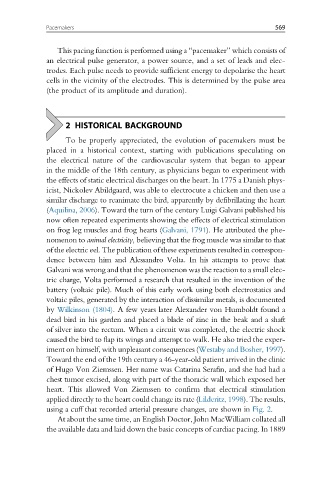Page 576 - Handbook of Biomechatronics
P. 576
Pacemakers 569
This pacing function is performed using a “pacemaker” which consists of
an electrical pulse generator, a power source, and a set of leads and elec-
trodes. Each pulse needs to provide sufficient energy to depolarise the heart
cells in the vicinity of the electrodes. This is determined by the pulse area
(the product of its amplitude and duration).
2 HISTORICAL BACKGROUND
To be properly appreciated, the evolution of pacemakers must be
placed in a historical context, starting with publications speculating on
the electrical nature of the cardiovascular system that began to appear
in the middle of the 18th century, as physicians began to experiment with
the effects of static electrical discharges on the heart. In 1775 a Danish phys-
icist, Nickolev Abildgaard, was able to electrocute a chicken and then use a
similar discharge to reanimate the bird, apparently by defibrillating the heart
(Aquilina, 2006). Toward the turn of the century Luigi Galvani published his
now often repeated experiments showing the effects of electrical stimulation
on frog leg muscles and frog hearts (Galvani, 1791). He attributed the phe-
nomenon to animal electricity, believing that the frog muscle was similar to that
of the electric eel. The publication of these experiments resulted in correspon-
dence between him and Alessandro Volta. In his attempts to prove that
Galvani was wrong and that the phenomenon was the reaction to a small elec-
tric charge, Volta performed a research that resulted in the invention of the
battery (voltaic pile). Much of this early work using both electrostatics and
voltaic piles, generated by the interaction of dissimilar metals, is documented
by Wilkinson (1804). A few years later Alexander von Humboldt found a
dead bird in his garden and placed a blade of zinc in the beak and a shaft
of silver into the rectum. When a circuit was completed, the electric shock
caused the bird to flap its wings and attempt to walk. He also tried the exper-
iment on himself, with unpleasant consequences (Westaby and Bosher, 1997).
Toward the end of the 19th century a 46-year-old patient arrived in the clinic
of Hugo Von Ziemssen. Her name was Catarina Serafin, and she had had a
chest tumor excised, along with part of the thoracic wall which exposed her
heart. This allowed Von Ziemssen to confirm that electrical stimulation
applied directly to the heart could change its rate (Lilderitz, 1998). The results,
using a cuff that recorded arterial pressure changes, are shown in Fig. 2.
At about the same time, an English Doctor, John MacWilliam collated all
the available data and laid down the basic concepts of cardiac pacing. In 1889

